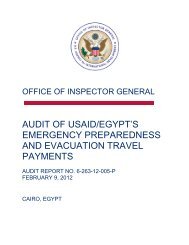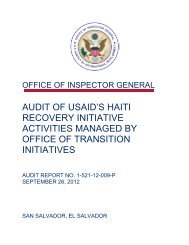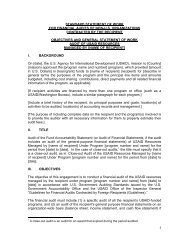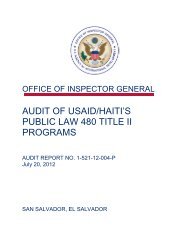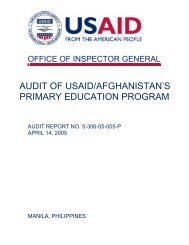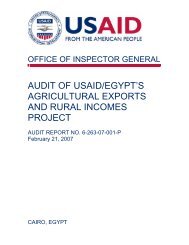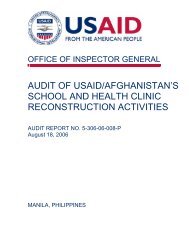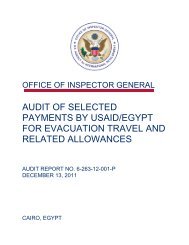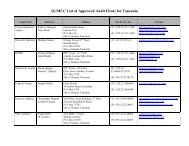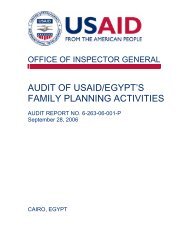USAID OIG Afghanistan and Pakistan Oversight Report, April-June ...
USAID OIG Afghanistan and Pakistan Oversight Report, April-June ...
USAID OIG Afghanistan and Pakistan Oversight Report, April-June ...
- No tags were found...
Create successful ePaper yourself
Turn your PDF publications into a flip-book with our unique Google optimized e-Paper software.
<strong>Afghanistan</strong> has one of the highest illiteracy rates in the world. More than 11 million Afghans over the age of15 cannot read or write. In rural areas, where three-fourths of all Afghans live, 90 percent of the women <strong>and</strong>over 60 percent of the men are illiterate. Under the Taliban, girls were not allowed to go to school, fewerthan 900,000 boys were enrolled, <strong>and</strong> many received religious education in lieu of academics. Theimplications of this lack of education can be felt in all domains of life. Afghans have little access toinformation about good health practices, <strong>and</strong> most of the country’s judges <strong>and</strong> civil servants do not havemore than a high school diploma. Today more than 5.7 million students attend school. However, the AfghanGovernment is striving to improve education for its people, <strong>and</strong> the Ministry of Education worked with<strong>USAID</strong> <strong>and</strong> other donors to implement a 5-year National Education Strategic Plan (2006–2010).The audit found that much of the training of teachers had been completed. For example, 50,600 of the targetof 54,000 teachers in the 11 provinces had received in-service training for teachers already working for theMinistry of Education. Although the project had not attempted to measure the extent to which teaching hadactually been improved, teachers we spoke with expressed satisfaction with the training they hadreceived. And much of the technical assistance to the Ministry of Education had been completed. Forexample, Creative Associates had assisted in recruiting <strong>and</strong> selecting most of the 444 c<strong>and</strong>idates who wereexpected to help the Ministry of Education develop its capacity to improve the quality of teaching.In addition, the audit found that district teacher training teams had been established to help conducttraining in all 11 provinces. This approach used a cascading process of training existing teachers asinstructors who in turn would train other teachers. The project teamed with subcontractors to select <strong>and</strong>hire 181 team leaders, 1,361 team members, <strong>and</strong> 8 provincial project monitoring officers, all by December2007. Moreover, the project developed (1) an action plan for the Ministry of Education’s 5-year strategicplan, (2) a human resources policy manual, (3) a training curriculum for management skills, <strong>and</strong> (4) anaction plan for the integration of the Human Resources Department <strong>and</strong> the Reform Implementation <strong>and</strong>Management Unit at the Ministry of Education.Notwithst<strong>and</strong>ing these accomplishments, the audit found that some significant tasks <strong>and</strong> activities includedin the project’s contract <strong>and</strong> work plan had not been completed. For example, the project had not completedthe curriculum development <strong>and</strong> related in-service teacher training or the accelerated program for teacherswho did not meet Ministry of Education teaching qualifications for their specific subject/grade level, asplanned under component 1 of the project. The project also did not complete some activities planned undercomponent 2—for example, technical assistance intended for the Ministry of Education’s Human ResourcesDepartment, such as development of a curriculum <strong>and</strong> staff training on a human resource database; creationof a training manual for the payroll database for budget staff; <strong>and</strong> preparation of at least one workshop onpedagogical methods for faculty at each provincial teacher training college. The contractor hoped tocomplete these efforts by the contract’s end.Audit of <strong>USAID</strong>/<strong>Afghanistan</strong>’s Civilian Assistance Program (<strong>Report</strong> No. 5-306-10-004-P, December 15,2009)The Civilian Assistance Program is being implemented through a $27 million, 3-year cooperative agreement(<strong>April</strong> 2007 to <strong>April</strong> 2010) with the International Organization for Migration. <strong>OIG</strong>’s audit found that theprogram—which is intended to provide help to Afghan families <strong>and</strong> communities that have suffered lossesbecause of military operations—was not on target to assist eligible program beneficiaries.84 <strong>USAID</strong> <strong>OIG</strong> <strong>Afghanistan</strong> <strong>and</strong> <strong>Pakistan</strong> <strong>Oversight</strong> <strong>Report</strong>



